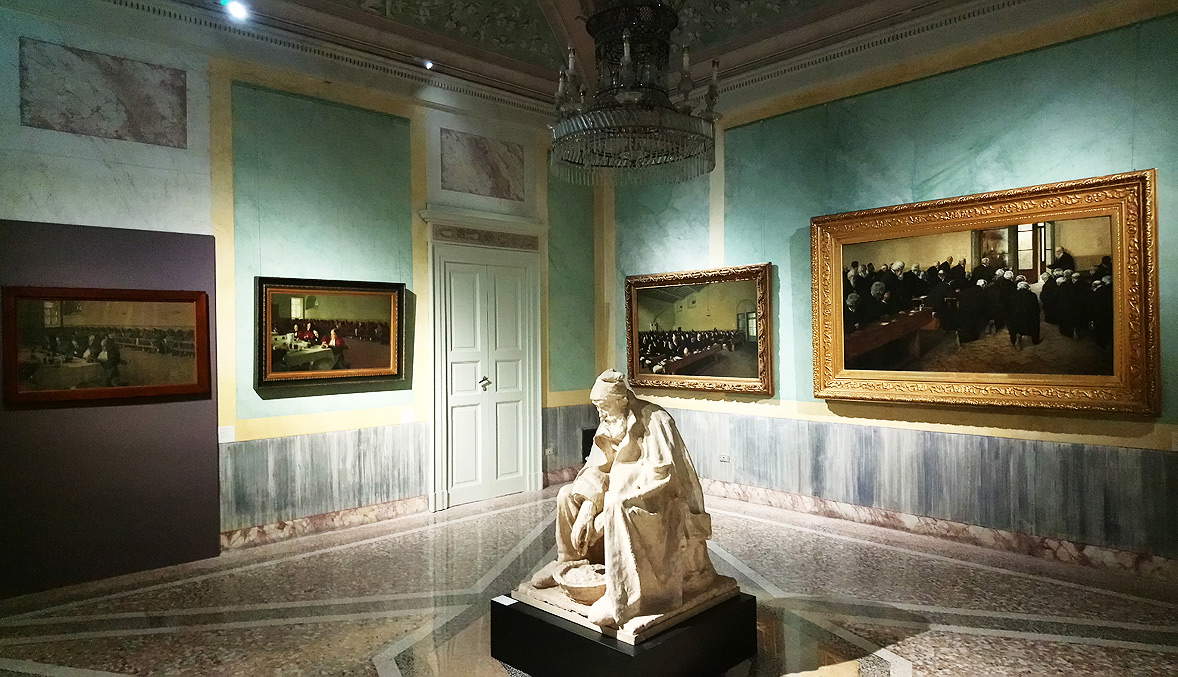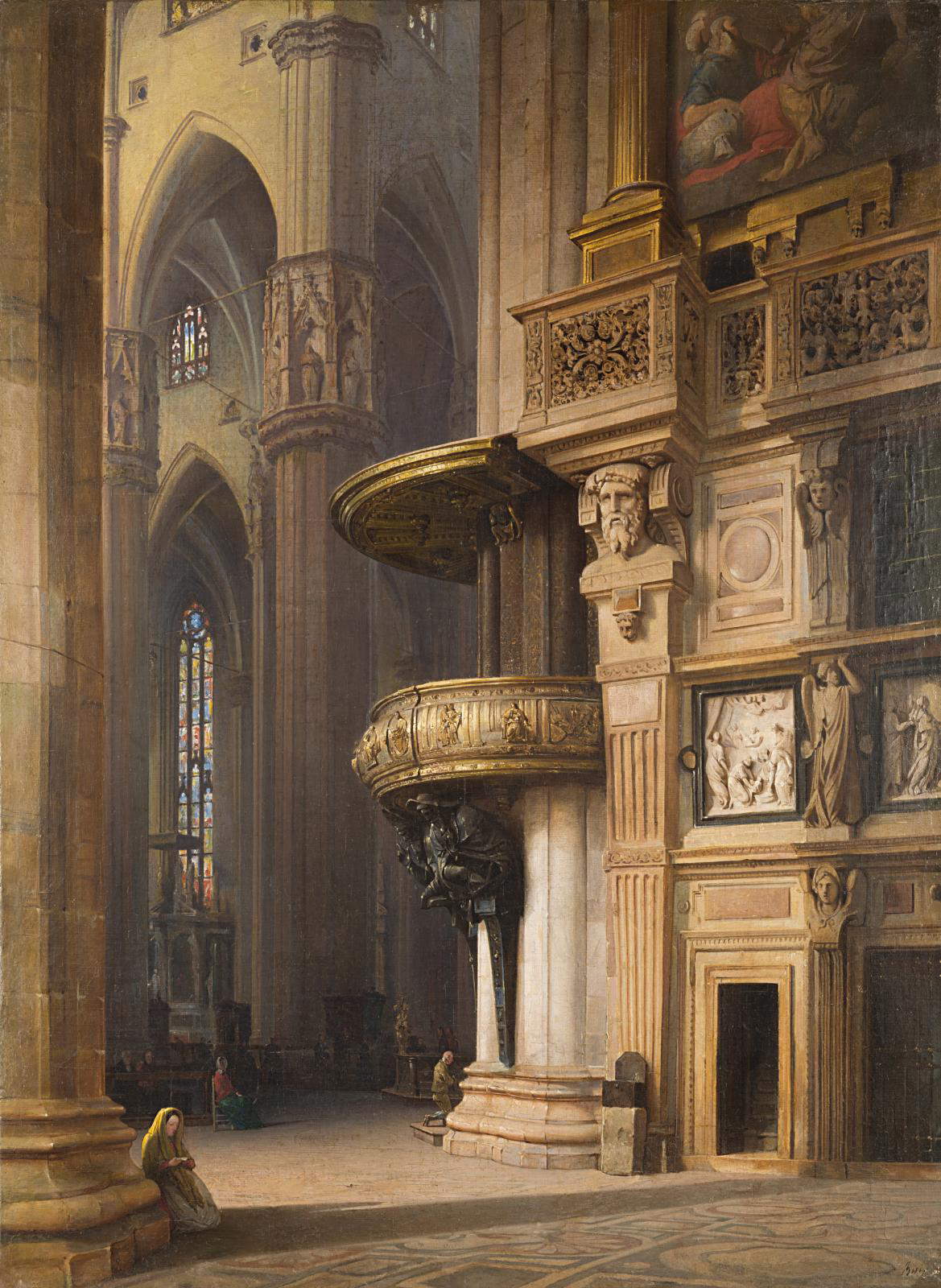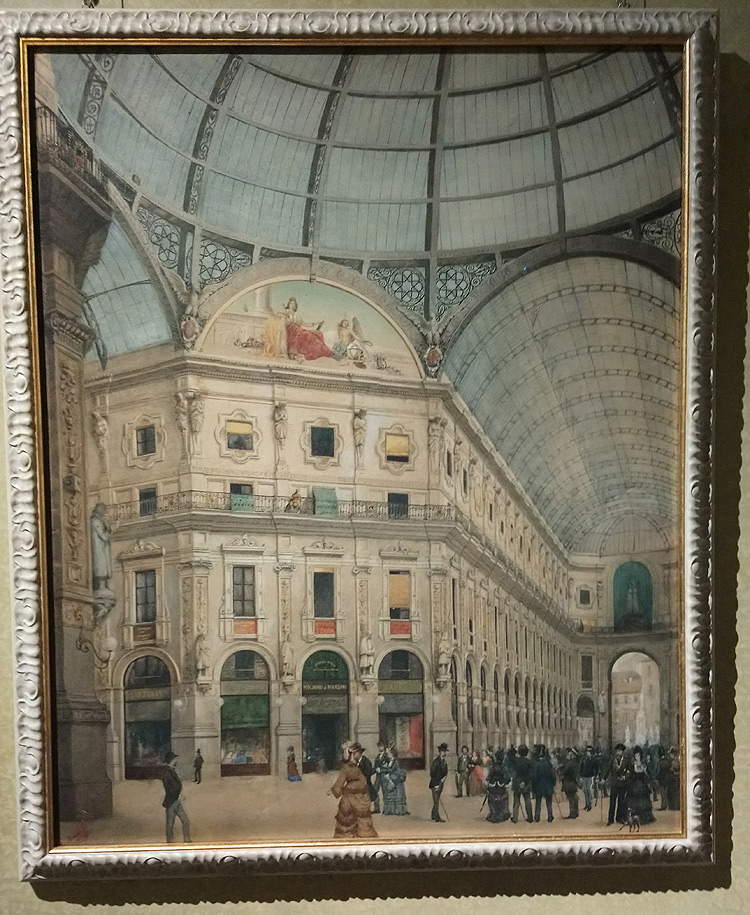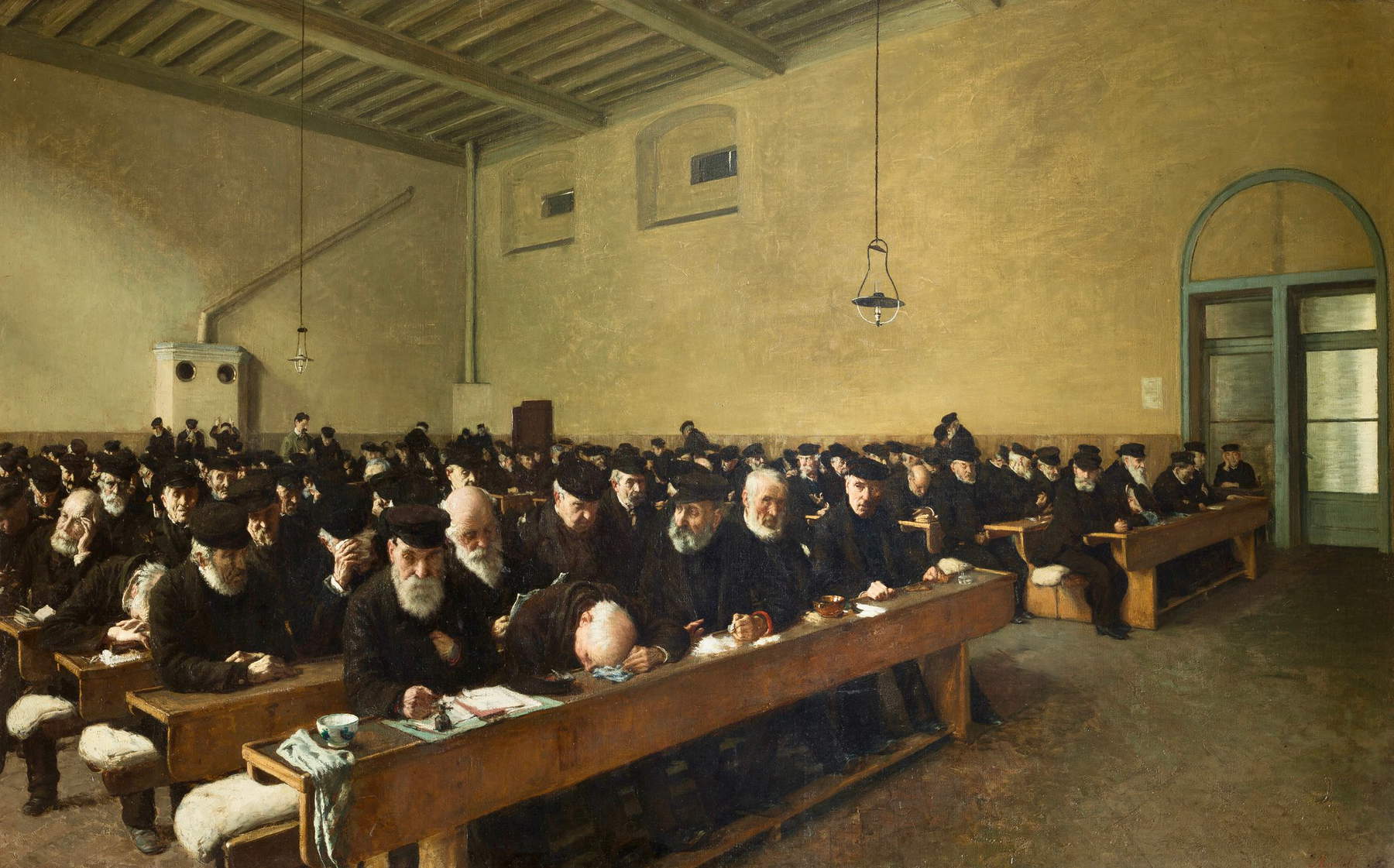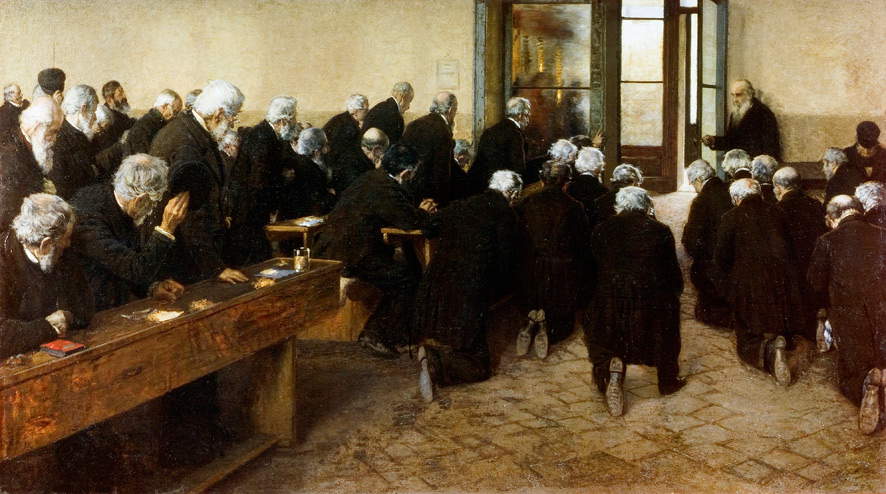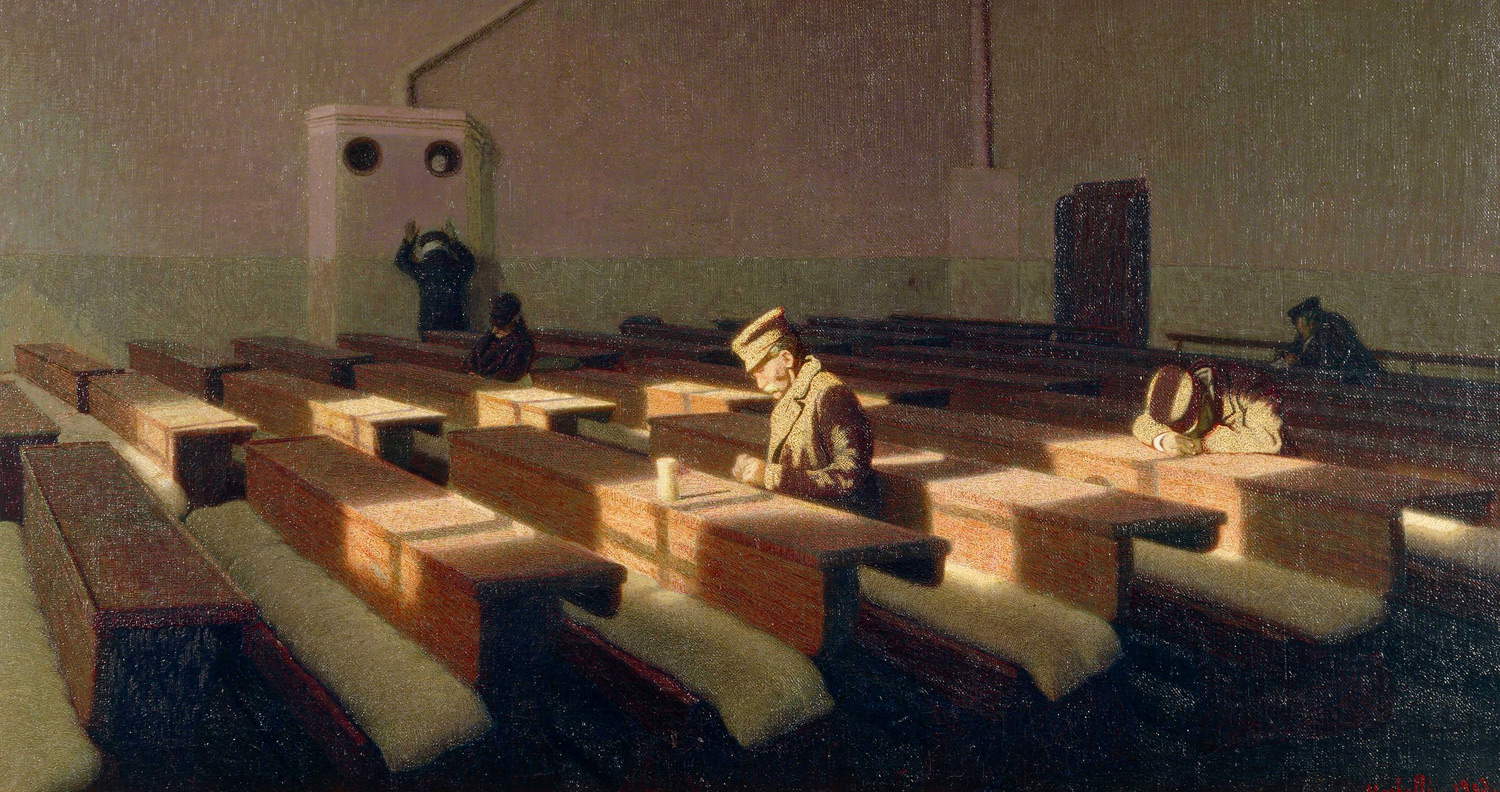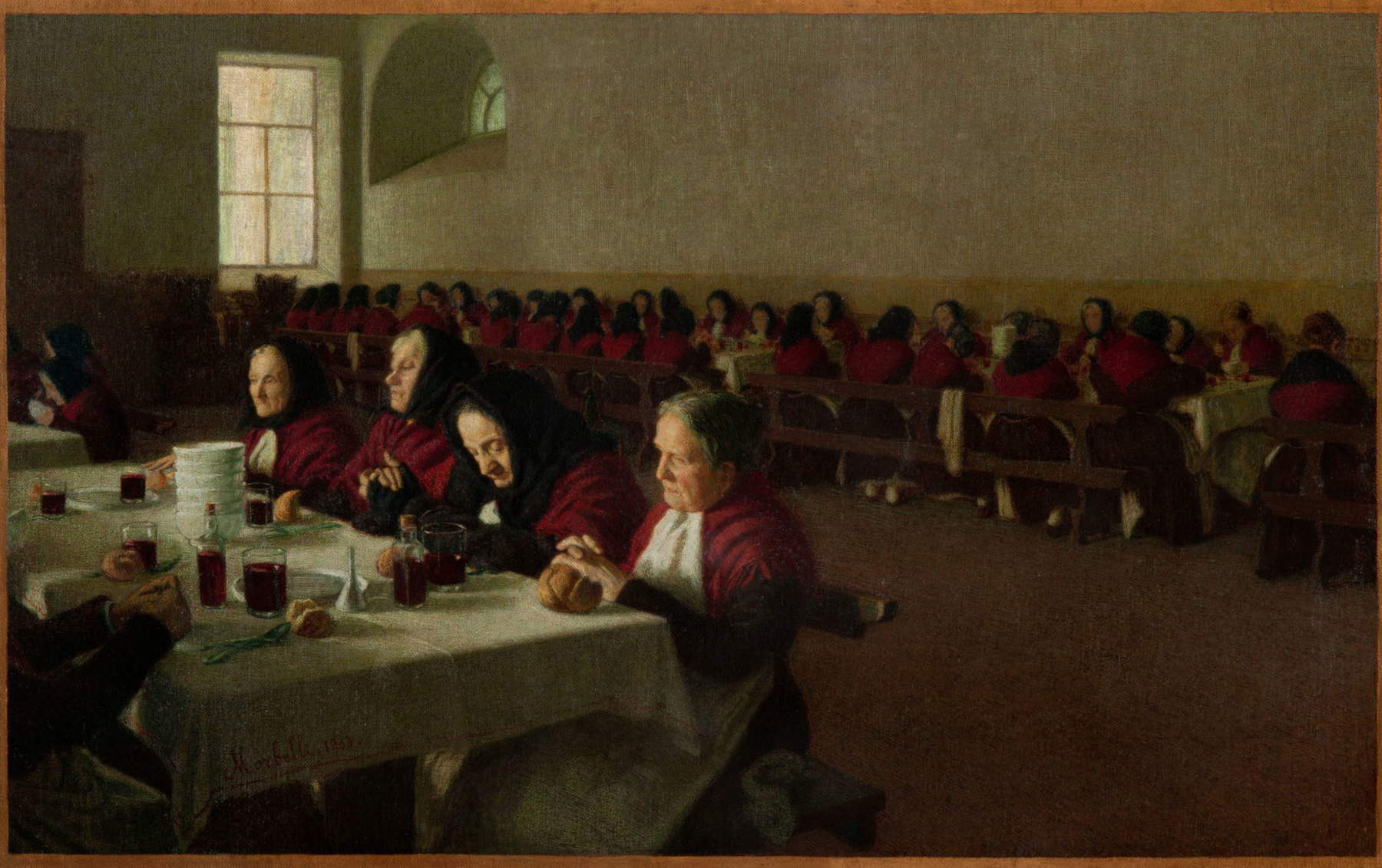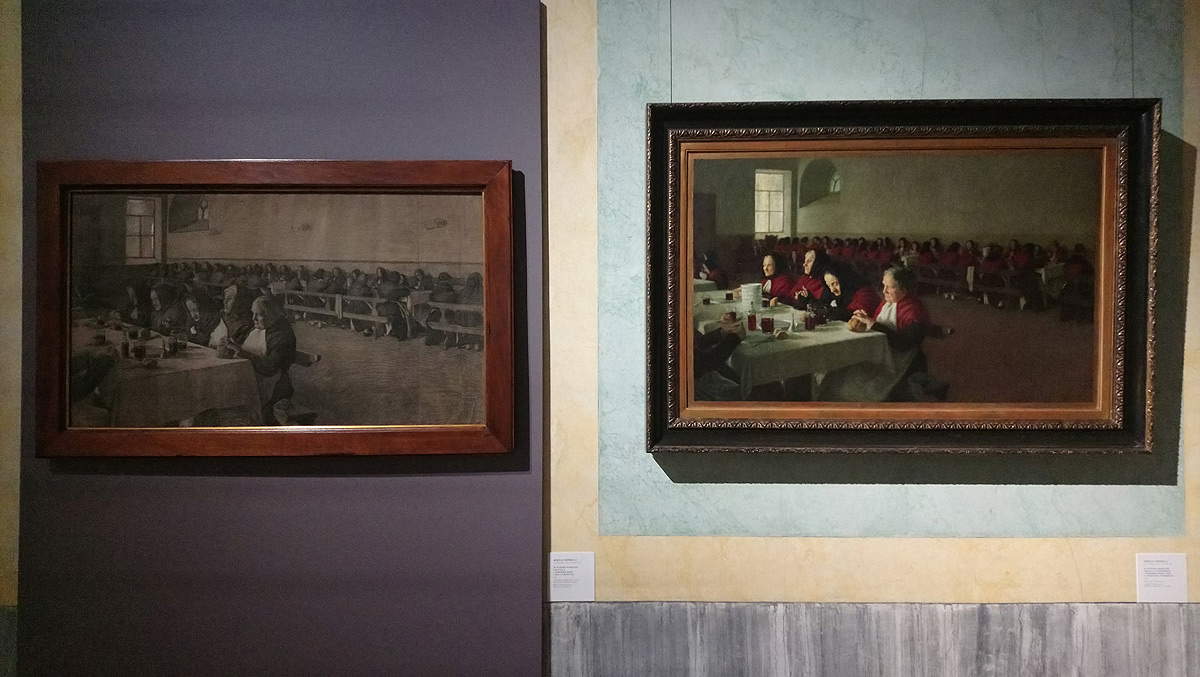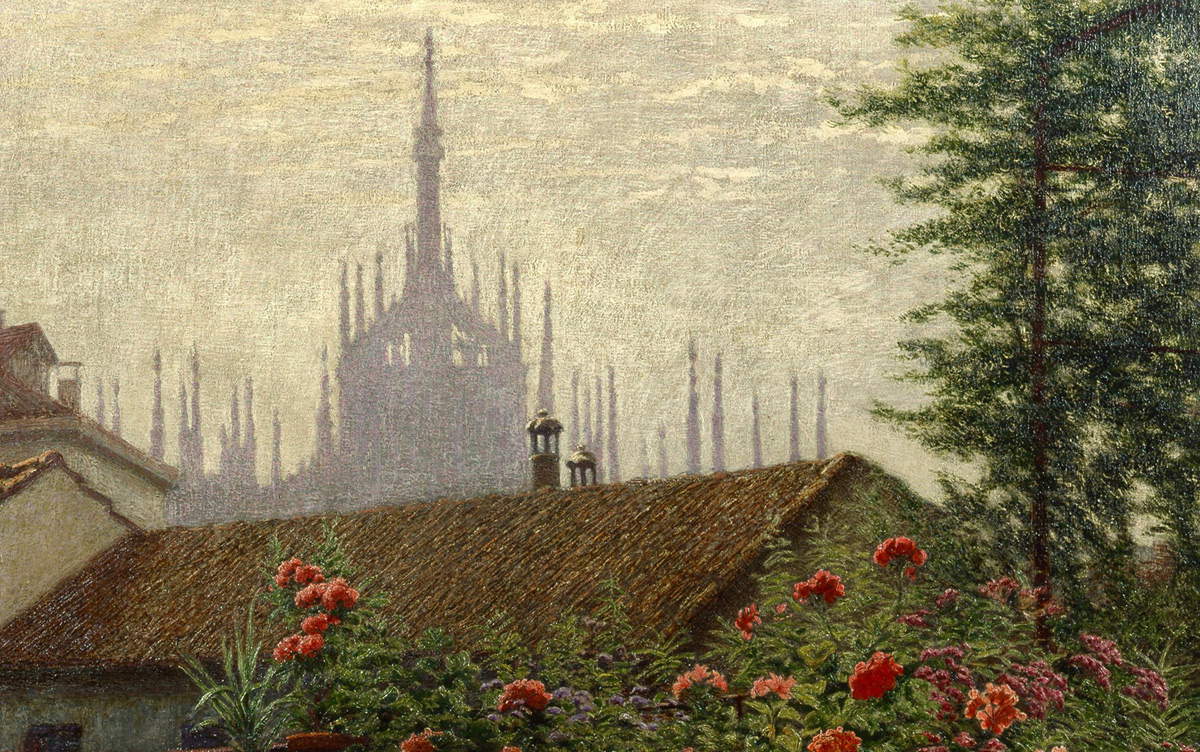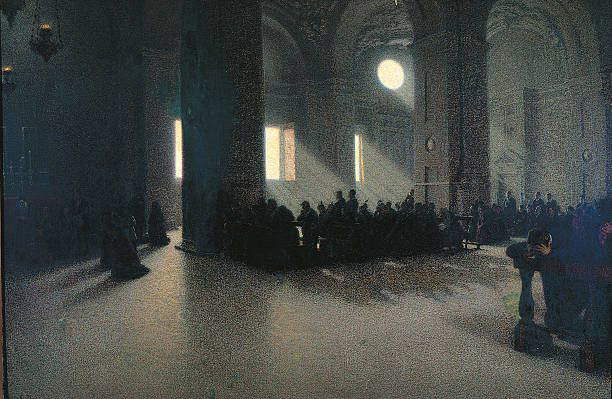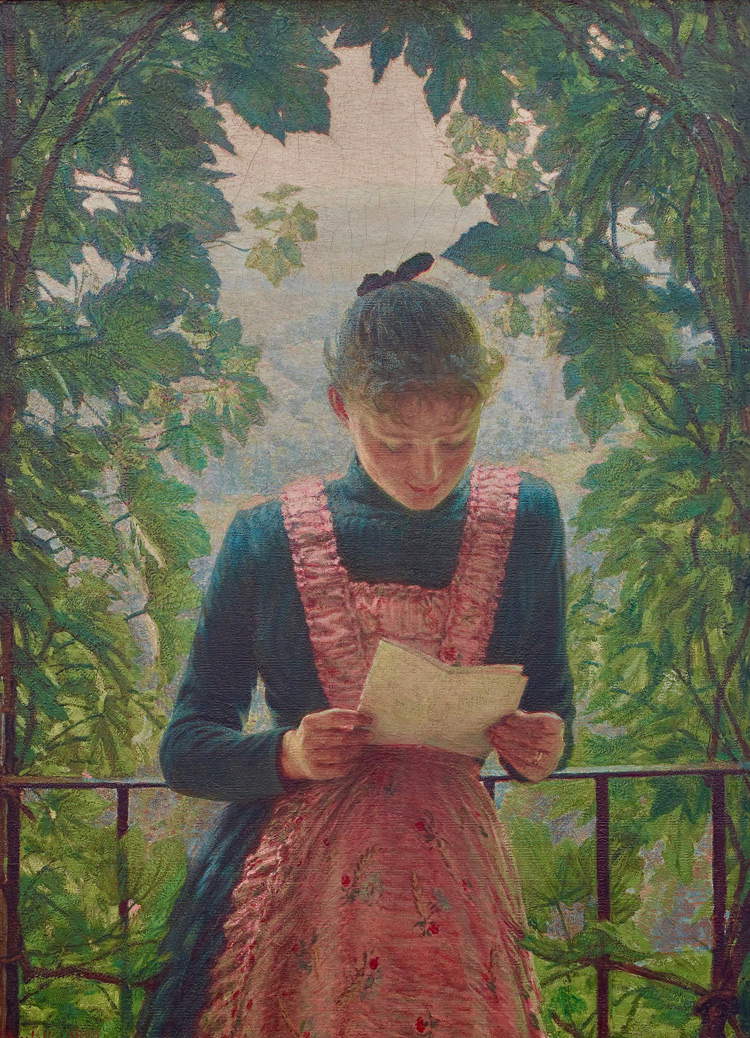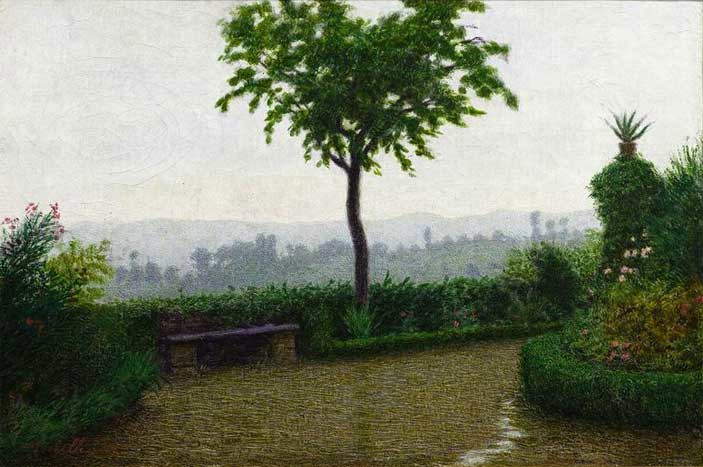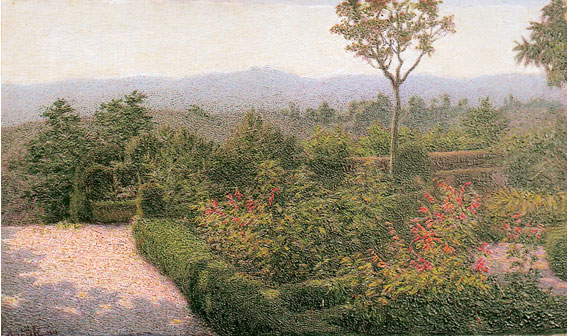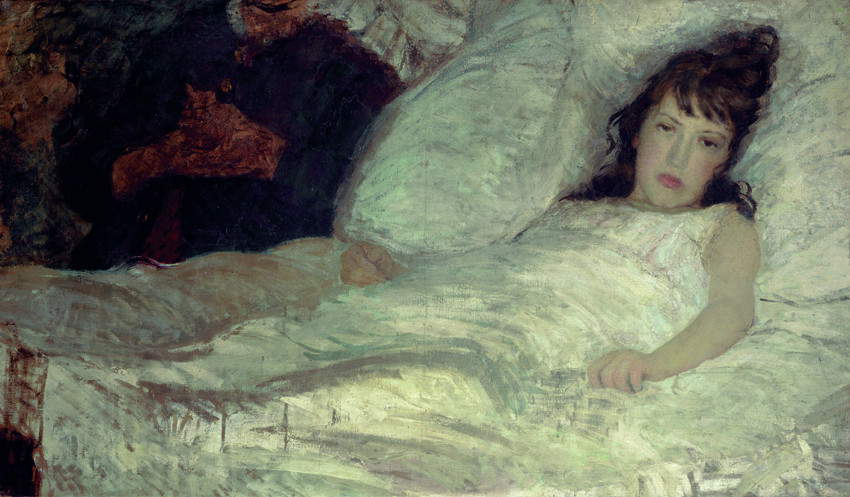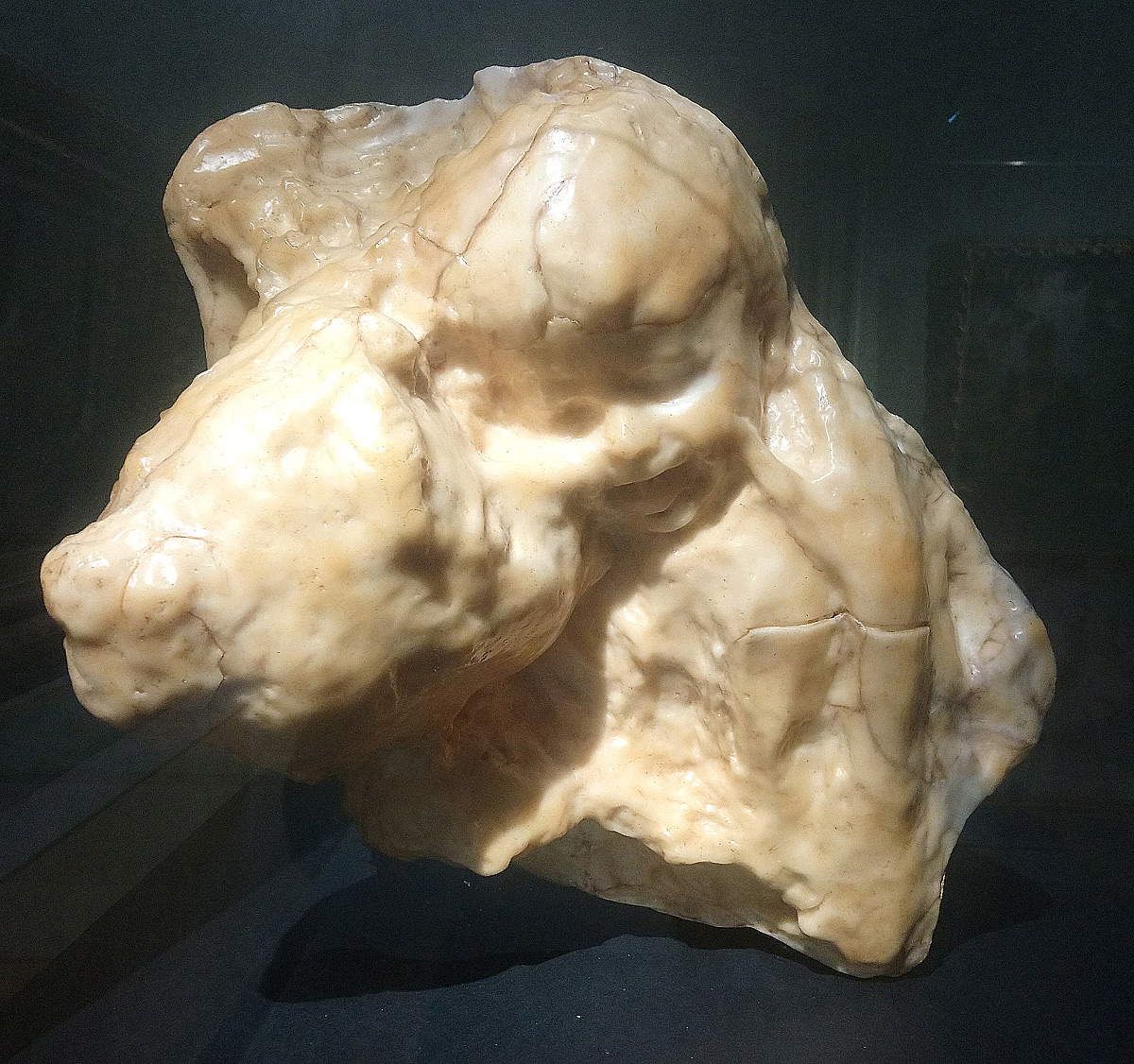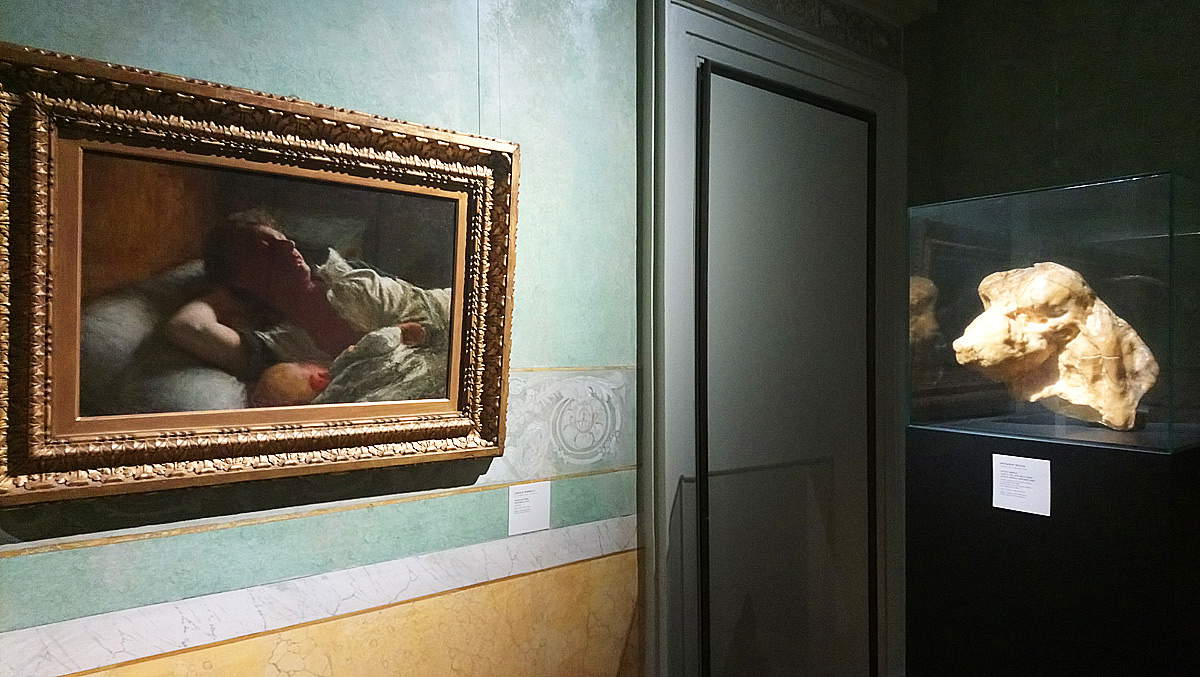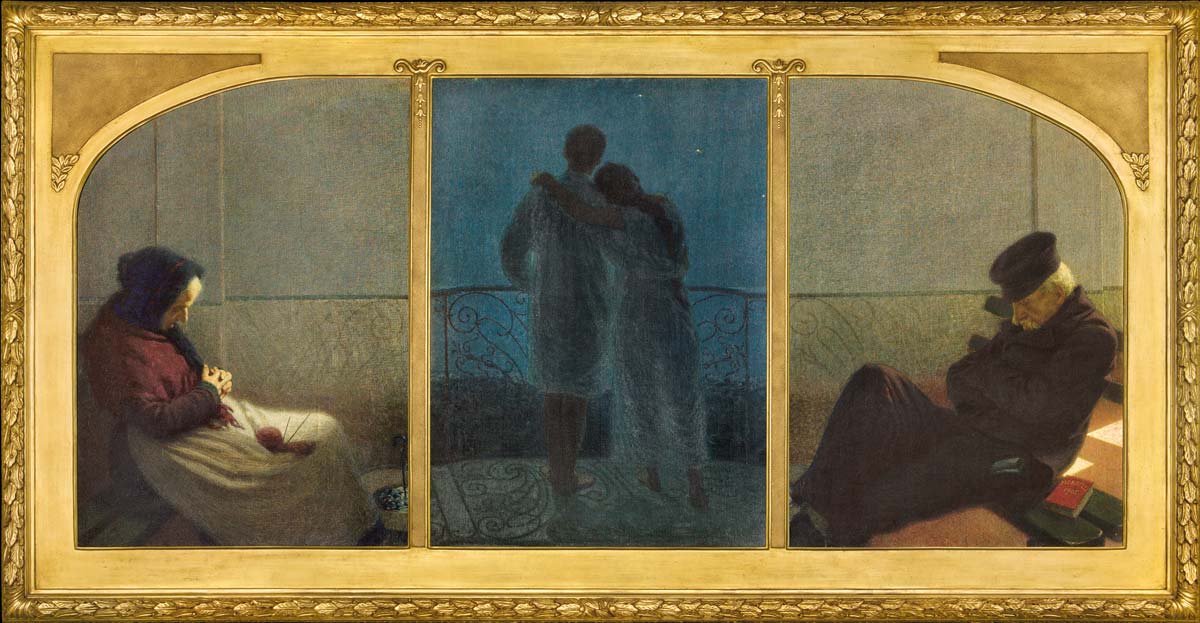by Federico Giannini (Instagram: @federicogiannini1), published on 06/05/2019
Categories: Exhibition reviews
/ Disclaimer
Review of the exhibition "Morbelli. 1853-1919" at GAM, Milan, from March 15 to June 16, 2019.
One of the most interesting and fruitful achievements of the exhibition Morbelli. 1853 - 1919, the valuable anthological exhibition that the Galleria d’Arte Moderna in Milan is dedicating to Angelo Morbelli (Alessandria, 1853 - Milan, 1919) on the centenary of his death, is the retrieval (with subsequent publication) of an unpublished letter that the great painter from Alessandria (but Milanese by adoption) sent to the critic Gustavo Macchi, probably at the beginning of the second decade of the twentieth century (the letter is not dated, but a possible temporal collocation can be derived from its contents). In the text, written in the pressing, colloquial and fervid style that was typical of Morbelli’s letters, the artist summarizes some of the fundamental characteristics of Divisionism, the movement of which he was a leading protagonist: “the so-called Divisionism,” the painter writes, “for me has a law like perspective, it is a resource like veiling; it certainly gives a transparent vision due to the phenomenon of the different lengths of undulation that reach the eye, and I think I can say (with an almost certainty), it gives a greater sensation of... planes.” This quick but juicy definition Morbelli gives of the style that saw him excel is also functional in being guided through the rooms that make up the Milanese exhibition: The curator Paola Zatti (who, moreover, together with the scholar Niccolò Dell’Agnello, publicized the letter) must be credited with having mounted an exhibition that, despite its brevity, proceeding with criteria that are both chronological and thematic, touches on almost all the fundamental subjects of Morbelli’s art, with a careful selection based on the works that make up the Morbellian nucleus in the municipal collections, and enriched by numerous loans of works that are capital in the great Divisionist artist’s career.
That the bond between Milan and Morbelli is very close is well known: the exhibition, in this sense, provides an opportunity to retrace not only the stages of the Piedmontese artist’s art, but also those of the city’s interest in him (and continues to have). An interest that, admittedly, began to take shape somewhat later than Morbelli’s achievement, who until 1912, despite his growing successes and the presence of his works in prestigious international museums, did not have the satisfaction of seeing one of his own paintings purchased by the city that had welcomed him as a teenager, where he had studied with some great masters, witnessed the formation of his unquestionable talent, and seen him exhibit and then excel: the City remedied only seven years before the artist’s passing, securing theWinter at the Pio Albergo Trivulzio. According to the reconstruction of Paola Zatti (who opens the exhibition catalog), to see another work by Morbelli become part of the Milanese public collections, it was necessary to wait until 1921, when his Giorni... ultimi! (Last Days!) came to the City following a donation: it was 1921, moreover, the year in which the Gallery of Modern Art was moved to its current location, the Villa Reale. Other works came to the civic collections in 1929(Tempo di pioggia), in 1931(La Stazione Centrale di Milano) and in 1935, when collector Luigi Beretta donated his collection to the City, which included the Duomo Spires and the Refectory of the Pio Albergo Trivulzio, now at the Museum of Milan (the institution deputed to house Beretta’s bequest, then in Palazzo Sormani and now in Palazzo Morandi). Instead, the last acquisition dates back to 1938, the Venduta donated to the Gallery of Modern Art by sculptor Cesare Ravasco. A brief historical summary to recall how GAM is the most suitable place to host a public exhibition on Angelo Morbelli.
 |
| A room of the exhibition Morbelli. 1853 - 1919 at the GAM in Milan |
 |
| A room from the exhibition Morbelli. 1853 - 1919 at the GAM in Milan |
 |
| A room from the exhibition Morbelli. 1853 - 1919 at the GAM in Milan |
The exhibition opens on the left wall of the first room, with an extraordinary comparison between Angelo Morbelli and one of his early masters, the Milanese Luigi Bisi (Milan, 1814 - 1886), best known for his views of interiors: the GAM houses an Interior of Milan Cathedral, moved to the exhibition for the occasion, in order to be displayed alongside Morbelli’s Galleria di Vittorio Emanuele in Milan. The juxtaposition is not only functional in showing how that “law of perspective” to which the artist from Alessandria alluded in his letter to Macchi was a rule that Morbelli followed from his earliest trials (he was only nineteen when he painted the Galleria Vittorio Emanuele), but it is also a vivid demonstration of the way the painter looked at reality contemporary to him. There is a gap of thirteen years between the two works (Bisi’s view of the Duomo is from 1859, his young pupil’s Galleria from 1872), but Morbelli’s watercolor, though still tied to traditional painting, already reveals elements of marked modernity that help widen the gap between the two artists: Morbelli, who was attending the Brera Academy of Fine Arts at the time, proposes a more open angle than the master’s, with a photographic cut that almost anticipates today’s taste, so that the viewer’s gaze widens to include even the Gallery’s roof, built of glass and steel, and already risen to a symbol of the metropolis in the midst of transformation (in 1864 the Central Station had been opened, another place in modern Milan that fascinated Morbelli, and a few years later the city would witness the founding of the Corriere della Sera, the opening of the first steam-powered tramways, and the inauguration of Europe’s first electric lighting network, which went into operation in 1883). A radically innovative subject (“it is not really an interior, but neither is it a building taken from the outside in its entirety,” Alessandro Oldani writes in the catalog, “rather it is an iron and glass envelope in which light penetrates and in which interior and exterior blur and cancel each other out”) that would soon become a privileged field of experimentation for photographers.
Without looking at the opposite wall (one will get there by turning back from the second room), one keeps to the left and arrives in the section devoted to Morbelli’s early interests in social issues, and in particular the plight of the elderly, a strand that the Piedmontese artist would continue to practice throughout his career. A work such as the aforementioned Giorni... ultimi! (Days... last! ) holds an essential importance in Morbelli’s career, for several reasons: it is, first of all, his first work set at the Pio Albergo Trivulzio, the ancient institute founded in 1766 at the behest of Prince Antonio Tolomeo Gallio Trivulzio and which since its opening had the function of a reception center for the city’s poor, particularly the elderly and infirm (a role it continues to play to this day). In Morbelli’s time, the Pio Albergo Trivulzio was still housed in Antonio Tolomeo’s palace, located in Contrada della Signora (the institute would be moved in 1910 to its current location, on the Via per Baggio, in a building specially constructed to meet more modern sanitary standards ): it became a place where Morbelli used to go to document a reality that until then had not yet enjoyed artistic dignity, to describe the most mournful and dramatic implications of the nascent industrial society, with a lucidity that, at the time, knew few equals, and that updated with a modern, investigative and merciless, though sharing, gaze a Lombard tradition that saw in artists such as Molteni or Domenico Induno the most direct precedents. When Morbelli awaited the realization of Giorni... ultimi! (Days... last! ) he was thirty years old: the exhibition of the painting at Brera, which earned him the Fumagalli Prize and favorable criticism, dates back to 1883. And the Pio Albergo Trivulzio became a place-symbol of Morbelli’s art, present in his paintings up to the extreme stages of his activity.
The second room of the exhibition is entirely dedicated to the theme of old age, examined by Morbelli in the bitter dimension ofabandonment andisolation on the margins of modern society, and with a gaze that also considers all the collateral aspects of that condition, starting with the death protagonist of Il viatico, a painting first exhibited in 1884 at Brera, also set at the Pio Albergo Trivulzio, and a description of a priest’s visit to the hospice to administer the sacrament of Extreme Unction to a dying guest, under the grieving gaze of the other old people who found welcome in the institution. Morbelli’s intentions became programmatic at the beginning of the twentieth century, when the artist set up a studio in the Pio Albergo Trivulzio (this was 1902) with the aim of producing a cycle that would consider all aspects of life in the Milanese nursing home: Thus was born, in 1903, the celebrated Poem of Old Age, moreover reunited in 2018, in a dedicated exhibition at the Galleria Internazionale d’Arte Moderna di Ca’ Pesaro in Venice, for the first time after what had until then been his only public exhibition, as part of the fifth Venice Biennale, held in 1903. From that exemplary cycle, an exceptional masterpiece of Divisionism, are present at GAM Il Natale dei rimasti, which deals with the painful theme of loneliness, and Mi ricordo quand’ero fanciulla, devoted instead to nostalgia and memories: in the exhibition, moreover, it is presented side by side with a detailed study on squared paper, kept in a private collection, which represented for the artist the final test before the final translation on canvas. This comparison is one of the highlights of the exhibition, and also commendable is the inclusion, in the center of the room, of a sculpture by Ernesto Bazzaro (Milan, 1859 - 1937), entitled Esaurimento, also successfully presented at the Milan exhibitions, and a useful corollary that contextualizes Morbelli’s production within the framework of an interest in social themes that had won over many artists.
 |
| Luigi Bisi, Interior of Milan Cathedral (1859; oil on canvas, 109.9 x 83.2 cm; Milan, Galleria dArte Moderna) |
 |
| Angelo Morbelli, The Galleria Vittorio Emanuele in Milan (1872; watercolor on cardboard, 84.50 x 68 cm; Monza, Roberto Pancirolli Collection) |
 |
| Angelo Morbelli, Last Days! (1882-1883; oil on canvas, 98 x 157.5 cm; Milan, Galleria dArte Moderna) |
 |
| Angelo Morbelli, Il Viatico (1884; oil on canvas, 112 x 200 cm; Rome, Galleria Nazionale dArte Moderna e Contemporanea) |
 |
| Angelo Morbelli, Il Natale dei rimasti (1903; oil on canvas, 61 x 110 cm; Venice, Fondazione Musei Civici di Venezia, Galleria Internazionale dArte Moderna di Ca Pesaro) |
 |
| Angelo Morbelli, Mi ricordo quandero fanciulla (Entremets) (1903; oil on canvas, 71 x 112 cm; Tortona, Il Divisionismo Pinacoteca Fondazione C. R. Tortona) |
 |
| Angelo Morbelli, Mi ricordo quandero fanciulla, comparison between the painting and the studio |
We return to the room from which the itinerary begins, but look to the right wall, which presents the public with the Spires of the Duomo and the Central Station, two paintings made at two very distinct moments in Morbelli’s career (the first is from 1915-1917 while the second dates back to 1899), but juxtaposed in that they are useful in reintroducing the themes of light and perspective that make up much of the exhibition’s backbone. The presence of works devoted to the train station (the one on display is a second version of a painting that the painter had presented at the Brera Exhibition of 1887, and which is now preserved in Rome, at the headquarters of the State Railways) is also a reflection of Morbelli’s constant attention to the reality of his time, but not only: it was from the 1980s onward that the artist, while maintaining firmly the rigorous perspective layout of his compositions, as indeed also happens in Central Station, began to abandon a painting adherent to the natural datum (the Galleria Vittorio Emanuele itself presented at the opening of the itinerary is an example of this) in order to experiment with new effects of light and innovative applications of theories on color perception ("One really has to undo oneself, he would write in 1912 in his notebook La via crucis del divisionismo, a series of notes on the technique of his paintings, “of the habit of considering colors only as hues, but rather as more or less pure lights, p.e. a pure emerald, more vibrant than another green, or the same, clear but mixed.”). In this sense, the display of the Duomo’s Spires alongside the Central Station is a functional expedient to bring out Morbelli’s experimentalism before delving into it with later sections: the Duomo ’s Spires thus deal with a classic iconographic theme of Milanese painting, but they bring innovations as much in the artist’s chosen cut (a rose garden and a roof stand in the foreground, and the spires appear behind) as in the luministic effects, with the vivid chromatics that enhance the profile of the pinnacles of the Milanese cathedral, which stand out behind a light, thin blanket of fog rendered with that disjointed brushstroke that had already become the painter’s typical stylistic signature.
Light is the protagonist of two works such as Incensum Domino and Solatium miseris, which open the third room and repropose the theme of interior views many years after his early works(Incensum Domino is from the early 1990s, while Solatium miseris is a painting from Morbelli’s last activity). The artist sets the two paintings inside the same building, the church of Santa Maria dei Miracoli in Milan: in the older of the two paintings, exhibited in Milan in 1892, the sunlight penetrating through the large windows and refracting on the atmospheric dust in rays that invest the figures of the faithful kneeling in prayer, thus creating a very balanced contrast of lit and shadowed parts (but not only that: note the masterful effect of the light that makes the inlays on the floor in the foreground shine). The same effects, albeit with a sparser palette, a more rarefied brushstroke, and an enlarged point of view, inspired Solatium miseris, which, like the painting made some fifteen years earlier, won acclaim from critics, who could not help but note the pathos, almost mystical, that the two works were capable of arousing. In her catalog essay, scholar Giovanna Ginex identifies Solatium miseris as a “precise point of arrival” in Morbelli’s Divisionist painting, and sees it almost as a summation of the artist’s observations, a summary of which, taken from an unspecified note kept in a private archive, is given in the art historian’s text: “Keeping the colors in front so low,” Morbelli wrote, “but taken with a light if not maximum, not even minimum, and sloping within the church, the colors mix, they aerate with the distanced backgrounds... not so the colors reproducing the light and radiating, they must, it seems to me, produce themselves as pure as possible. / Keep the whole painting in large masses and in mystery, details must disappear, borders blurred, figures ditto, must finally predominate the clear dark-windows! and penumbra church!!! (take good care of the composition, before fixing the coal, not to have regrets).” Closing the circle by underscoring the value of Morbelli’s experiments is Alla sorgente tiepida, a painting by Vittore Grubicy de Dragon (Milan, 1851 - 1920), a friend of the Alexandrian artist and like him engaged in the work of renewing the element of light in landscape painting, as evidenced by the radiant luminism with narrative accents that permeates his painting, also dating from the 1990s.
 |
| Angelo Morbelli, The Spires of the Duomo (1915-1917; oil on canvas, 50 x 80 cm; Milan, Palazzo Morando costume, fashion, image) |
 |
| Angelo Morbelli, The Central Station of Milan in 1889 (1889; oil on canvas, 58 x 100 cm; Milan, Galleria dArte Moderna) |
 |
| Angelo Morbelli, Incensum domino! (1892-1893; oil on canvas, 80.3 x 119.9 cm; Tortona, Il Divisionismo Pinacoteca Fondazione C. R. Tortona) |
 |
| Angelo Morbelli, Solatium miseris (1914; oil on canvas, 130 x 199 cm; Milan, private collection) |
Landscape, moreover, is the protagonist of the works that Morbelli created in his refugium at Colma, a hamlet of Rosignano Monferrato where the artist used to stay to indulge in moments of rest in the countryside: precisely at Colma, writes Aurora Scotti in the catalog, Morbelli "fine-tuned the new Divisionist technique by practicing en plein air, in a gradual path of lightening of the chromatic range, through the choice of episodes of life and landscape views in the immediate vicinity of his home." a path that finds a climax in The First Letter, a work from 1890 that depicts the artist’s young wife, Maria Pagani, intent on reading a missive in the leafy garden of the Colma (and perhaps because of the intimacy that transpires from this work, one of the masterpieces of the Piedmontese artist’s poetics of affection, Morbelli resolved not to exhibit it in public as he initially thought of doing, assuming he would send it to the Brera Triennale). This is a painting where a thirty-seven-year-old Morbelli finally seems to arrive at the desired lighting effects: the artist models the figure of his consort in a delicate backlight (note the glow on her cheeks and hands) enclosed on the sides by the foliage of the trees that almost act as a frame. It is evident how the Colma estate was not only a place of leisure, but also of experimentation: here, among the Monferrato fields, the painter had the opportunity to grapple with the changing seasons, weather conditions, and moments of the day, as is well testified by two paintings that the exhibition with merit places side by side, namely the aforementioned Time of Rain and the earlier Giardino alla Colma, made five years apart (the first is from 1916, 1911 the second), but in the same place (the point of view changes slightly), and with the now acquired divided brushstroke experimenting with different lights and tones on a bad weather day and with the sun illuminating the garden giving rise to vibrant luministic effects (note the bushes among the hedges) that the artist outlines with meticulous accuracy.
Also driven by the desire to experiment is one of Morbelli’s crudest works, Pall Mall Gazette (Sold!), exhibited for the first time in London in 1888: with this painting the painter offered a touching testimony on the theme of child prostitution, which had been the subject of an investigation by the Pall Mall Gazette newspaper (hence the work’s title) just at that time, and on which the artist returned for the second time, four years after the first edition (he would later execute a third version of the painting in 1897). The protagonist is a very young girl, a teenager, who lolls mournfully and disconsolately on a bed, her arms stretched out along her sides, her hair tousled, her gaze resigned, dull and almost lifeless. The sadness of her eyes (and which is an eloquent indication of Morbelli’s affectionate participation, who cared for the last and the marginalized because he truly felt sorry for them) contrasts with the dazzling white of the sheets, a symbol of lost whiteness and innocence. The days of pointillism were still to come, but Morbelli performed some interesting experiments on the use of color (well elucidated by Gianluca Poldi in the catalog): for his Venduta, the painter tried a pastel preparation, then went over it all with tempera spread in broad, dense brushstrokes, probably because he was dissatisfied with the first stages of the work, and therefore perhaps wished to achieve greater luminosity with tempera. More reassuring female figures are to be found in the paintings on the theme of motherhood, moreover placed in fruitful dialogue with an Aetas aurea by Medardo Rosso (Turin, 1858 - Milan, 1928) to emphasize similarities in the rendering of affections: a work such as Happy Dawn, from a private collection, is set on a photographic cut similar to that of Sold, and again the protagonist is the backlight in which the figures of the mother and her child move at the moment of awakening, while the glow of the first morning light begins to appear beyond the windows making the fabrics of the curtains shine and giving vitality to the whole scene. This is one of the high points of the first phase of Morbelli’s career, a peak that the artist had reached by degrees: it is impossible not to mention, for example, the contrasts of light and shadow in Amor materno, a work slightly earlier but perhaps even more intimate than Alba felice (it will be appropriate to recall that the artist, in order to arrive at a satisfactory result, took advice from his wife for a more natural definition of the poses).
We finally arrive at the last room, where Morbelli’s mature production is investigated on the path that would lead Italian painting toward Symbolism. Morbelli himself seems not to be immune to these new sensibilities: interesting in this sense is Il ghiacciaio dei Forni, a landscape piece executed during a stay in Santa Caterina Valfurva, Valtellina, in 1910. Morbelli, in all likelihood, intended to propose a landscape that would be first and foremost evocative, and for that reason he opted for an unprecedented cut for a glacier, with a close-up on a snowy expanse cut obliquely, while the peaks are left far away, in the background, with the result that the typical color relationships in representations of glaciers are discombobulated (everyone will be familiar with the more traditional cut for a mountain, with the dark rocks at the bottom of the painting or photograph, and the snow-capped peaks above, with which Morbelli himself ventured, for example in Ave Maria, a work, however, not exhibited at GAM: here, however, the artist boldly performed the exact opposite operation). It closes with the pure, intimate and melancholy emotion of Dream and Reality, also known as the Triptych of Life, a 1905 painting, meditative and steeped in nostalgia, which can rightly be considered a kind of appendix or closing to the Poem of Old Age. In the two side panels are the solitary figures of two poor elderly people illuminated by faint glows that barely light up their faces left against the light: they sit in a domestic interior, she with her hands clasped on her chest as she contemplates a ball of yarn, and he who seems almost drowsy. A couple, having reached the extreme stages of existence: absorbed, gloomy and dark in the face, pensive, they repeat their daily gestures at a slow cadence as they leave behind them the inexorable passing of time, which becomes a further motif of Morbelli’s reflection. In the center, a panel shows us an image of them as young people: they are standing in front of a balustrade, gazing at the starry sky, she rests her head on his shoulder, they whisper words to each other filled with sweetness, they embrace. It is the dimension of remembrance, of the happy age that cannot return, and the realization that the future holds other and more bitter situations, and it is, one might think, the condemnation of the guests of the Pio Albergo Trivulzio, obliged to live by recalling the past and the lived experience to make a present made of anguish and loneliness less bitter, sad and unpleasant. Joy and suffering, happiness and disappointment meet to make the title of the work clear and manifest. The plot of life.
 |
| Angelo Morbelli, The First Letter (1890-1891; oil on canvas, 106.5 x 78.5 cm; Milan, private collection) |
 |
| Angelo Morbelli, Time of Rain (after the rain) (1916; oil on canvas, 33.5 x 50 cm; Milan, Galleria d’Arte Moderna) |
 |
| Angelo Morbelli, Giardino alla Colma (1911; oil on canvas, 36.5 x 58 cm; Milan, Museo dei Cappuccini) |
 |
| Angelo Morbelli, Pall Mall Gazette (Sold!) (1887-1888; tempera on canvas, 70 x 120 cm; Milan, Galleria dArte Moderna) |
 |
| Angelo Morbelli, Happy Dawn (1892-1893; oil on canvas, 50 x 103 cm; Milan, private collection) |
 |
| Medardo Rosso, Aetas aurea (Age dor; Age of Gold; Maternity) (posthumous casting by Francesco Rosso on an 1886 model; wax on plaster, 43 x 44 x 38.5 cm; Milan, Galleria dArte Moderna) |
 |
| Comparison between Morbelli’sAmor Materno and Medardo Rosso’s Aetas Aurea |
 |
| Angelo Morbelli, Il ghiacciaio dei forni (1910-1912; oil on canvas, 75 x 94 cm; Milan, private collection) |
 |
| Angelo Morbelli, Dream and Reality (Triptych of Life) (1905; oil on canvas, three panels, 112 x 80 cm, 112 x 79 cm, 112 x 80 cm; Milan, Fondazione Cariplo collection) |
The GAM exhibition certainly does not claim to be all-encompassing (many important works are missing: think of Asfissia, Battello sul lago Maggiore, or the works that narrate the working conditions in the Piedmontese rice fields), but this has not prevented the curator from ordering a rich and timely exhibition: the figure of Angelo Morbelli emerges as an extraordinary protagonist of his time, and the review, in addition to composing a rapid but significant fresco of late 19th-century painting in Italy, through a solid layout well emphasizes the great modernity of an artist who, as Paola Zatti writes, “contributed decisively to the evolution of Divisionist painting through a conscious and thoughtful technical experimentation; because he imaginatively devised unprecedented compositional cuts destined to make later generations reflect; because he succeeded in depicting certain glimpses of life with a dry realism, devoid of rhetoric, in images so full of their time that they constitute some of the most effective visual documents of his era.” Of course, Angelo Morbelli’s stature was already well known (and it is then necessary to add that it had already been fully understood even by his contemporaries), and this is not the first monographic exhibition dedicated to the great Divisionist (although a review in his Milan had been missing for seventy years), but the refinement of the itinerary of this centenary exhibition, the brilliant juxtapositions, the clear, functional apparatuses that are also suitable for a wide audience, the fact that the exhibition was built around works from the permanent collection while also evoking its history, the acquisition of the unpublished letter, and the value of the agile catalog, are all elements that contribute to making Morbelli. 1853 - 1919 an important point of passage in the field of studies on the artist and on all Divisionism.
It should also be added that one of the leitmotifs of the exhibition (indeed, it is perhaps the theme that links all the rooms) is the relationship between Morbelli and Milan, which is followed throughout the painter’s career, from his training with Luigi Bisi to the experimental works of his maturity: another element that enhances the exhibition, according to a dual perspective (the transformations of Morbelli’s poetics recounted through the glimpses of the city and the artist’s successes, which almost always moved from the Lombard capital, and in a sense also the history of Milan narrated by the painter). It remains, in the end, to wonder whether this strong link with the city, the context in which the exhibition was set up, its pleasant and well-organized narrative, and, of course, the unquestionable charm of Angelo Morbelli’s painting, will be sufficient elements to ensure that the art of the great artist from Alessandria can finally enter the chords of a wide audience, as it deserves.
Warning: the translation into English of the original Italian article was created using automatic tools.
We undertake to review all articles, but we do not guarantee the total absence of inaccuracies in the translation due to the program. You can
find the original by clicking on the ITA button. If you find any mistake,please contact us.
